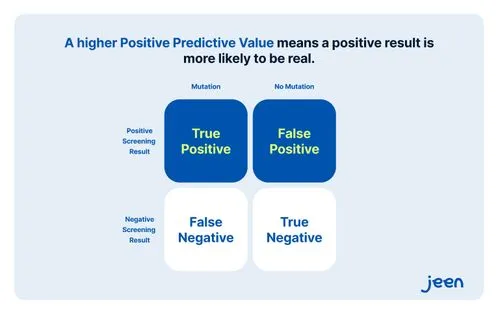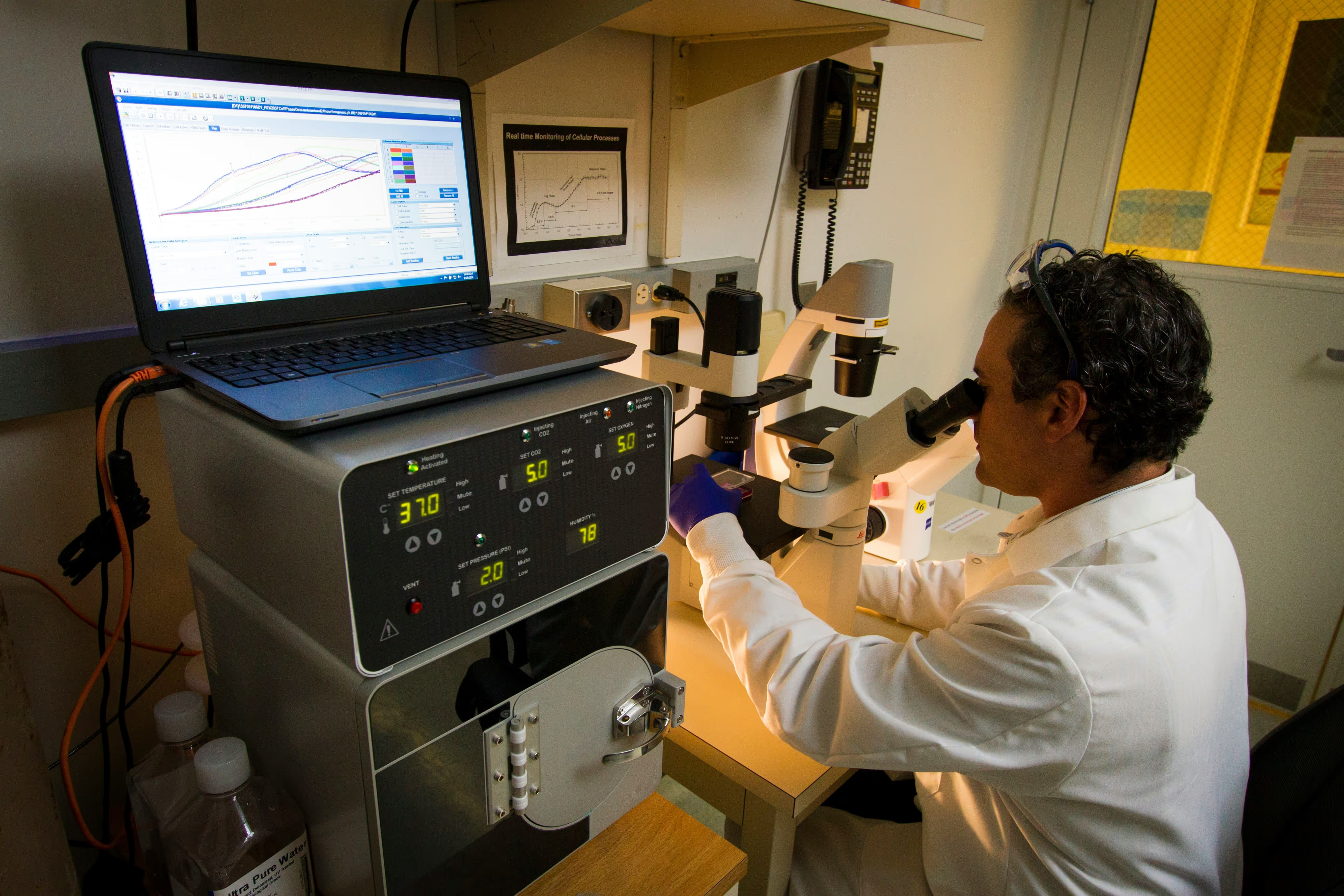
The period between 11 and 14 weeks, when the fetal crown–rump length (CRL) measures 45–84 mm, is the standard time for NT measurement
Chat with our Genetic Counsellor, receive your at-home DNA kit with a quick cheek swab, send it back, and get your results in under 4 weeks.




.avif)
.avif)


There are three different periods when nuchal thickness can be measured
At 10 weeks, NT can be measured accurately and may be a more sensitive early sign of possible problems, allowing prompt reassurance or testing.
This is the traditional time for NT assessment as part of the Combined Screening Test (CST). In the UK and many other countries, most babies have their NT measured during this stage of pregnancy.
After 14 weeks, the fluid behind the baby’s neck usually disappears, making the NT measurement unreliable. Instead, a different marker called the nuchal fold (NF) can be measured at this stage.
Increased NT Cut-off day by day chart.
Carrier screening is a type of genetic test that checks whether you carry a gene for a hereditary condition, even if you don’t have any symptoms yourself. It’s most often used by individuals or couples planning a family, to understand the risk of passing on certain inherited conditions to their children.
Everyone carries some changes in their genes, but most don’t cause any health problems. Carrier screening looks for specific conditions that could be passed on if both partners carry the same faulty gene. If both you and your partner are carriers for the same condition, there’s a chance your child could be affected.
Surprisingly, there is no international consensus on the name for the test combining NT measurement with hCG and PAPP-A to estimate chromosomal risk, and it is known by different names in different countries.
Below is a list of the most commonly used terms:
Combined Screening Test (CST) – UK
First Trimester Screening (FTS) – USA
Combined First Trimester Screening (CFTS) – Australia, New Zealand, Canada
First Trimester Combined Test (FTCT) – Europe
First Trimester Combined Screening (FTCS) – international
Combined First Trimester Test (CFTT) – international
Early Combined Test – Europe
Down Syndrome Combined Screening – outdated
The CST misses about 10–15% of babies with Down syndrome and has a false positive rate of up to 5%. It also has a limited scope, as it screens only for the most common chromosomal conditions (trisomies 21, 18, and 13) and does not detect the wider range of genetic syndromes or structural anomalies. Overall, it is significantly less accurate and less comprehensive than NIPT.
Yes, carrier screening is highly accurate at detecting known gene variants associated with inherited conditions. However, no test is 100% perfect, it’s possible, though rare, to be a carrier for a very rare or unknown variant not covered by the test.
At Jeen Health, we use advanced laboratory techniques and clinically validated panels to provide the most accurate results possible. Your results are interpreted by specialists to ensure they’re meaningful and reliable.
Mostly yes, you can have carrier screening during pregnancy - depending on how far along you are. Ideally, carrier screening is done before conception so you have more time and options, but it’s still valuable if you’re already pregnant.
If you’re found to be a carrier during pregnancy, we may recommend testing your partner too. If both partners carry the same gene variant, there’s a 1 in 4 (25%) chance the baby could inherit the condition. Our genetic counsellors will support you through the next steps.
PAPP-A is a protein produced by the placenta that plays a key role in supporting the baby’s growth and the health of the pregnancy. It helps regulate important growth factors (IGFs) that promote the development and function of the placenta and the growth of the baby.
By supporting the growth and differentiation of trophoblast (placenta) cells, PAPP-A is essential for healthy implantation and placental function. When PAPP-A levels are lower than normal in the first trimester, there may be a higher risk of complications such as fetal growth restriction or pre-eclampsia (PET) later in pregnancy.
Yes —
Carrier screening is recommended for anyone planning a pregnancy or currently expecting, especially if there's a family history of genetic conditions or if you come from an ethnic background with higher risks of certain inherited diseases. However, even people with no known history can be carriers without knowing it.
It’s particularly helpful for couples who want to make informed decisions about starting a family. Carrier screening can provide peace of mind or allow you to explore options like IVF with genetic testing, egg or sperm donation, or early diagnosis and support if you decide to conceive naturally.
Carrier screening can be done easily and painlessly. Most people use an at-home saliva kit, collecting a cheek swab with a soft swab in just a few minutes. In some cases, depending on your location and test type, a blood sample may be required, this can be arranged either at our partner Spital Clinic in London or through a home phlebotomy visit.
Once your sample reaches the lab, your DNA is analysed to check for specific gene variants linked to inherited conditions. Our expert team will review the results, and you'll receive a detailed report along with a follow-up consultation to walk you through what it means for you and your family.
If you’re a carrier, it means you have one copy of a gene variant linked to a particular condition. You won’t usually have symptoms, but if your partner is also a carrier for the same condition, there’s a risk of passing it on to your child.
Our genetic counsellors will talk you through your results and what they mean. Depending on your partner’s results and your family plans, you may consider further testing, reproductive options, or simply keeping this information in mind for the future.
If you’re a carrier, it means you have one copy of a gene variant linked to a particular condition. You won’t usually have symptoms, but if your partner is also a carrier for the same condition, there’s a risk of passing it on to your child.
Our genetic counsellors will talk you through your results and what they mean. Depending on your partner’s results and your family plans, you may consider further testing, reproductive options, or simply keeping this information in mind for the future.
It’s ideal for both partners to be tested, but we usually start by testing one. If that person is not a carrier, no further testing is needed. If they are, then their partner should be tested to check for the same condition.
This step-by-step approach helps keep testing straightforward and cost-effective. Our team will guide you based on the results and help you understand your reproductive risks together.
Both PAPP-A and NT are important first-trimester markers, but they reflect different biological processes.
PAPP-A is produced by the placenta and reflects placental health and function. Low levels may indicate poor placental development or chromosomal abnormalities.
NT (nuchal translucency) reflects the baby’s condition, especially the development of the heart, lymphatic system, and connective tissues. Increased NT is linked mainly to chromosomal, genetic, or structural fetal conditions, not directly to placental function.
When interpreted together, PAPP-A and NT help clinicians identify pregnancies at higher risk for chromosomal or structural abnormalities, providing a more complete early assessment of fetal wellbeing.
X-linked conditions are genetic disorders caused by changes in genes found on the X chromosome — one of the two sex chromosomes. Since males only have one X chromosome (and one Y), if they inherit a gene variant on the X chromosome, they’re more likely to be affected by the condition. Females have two X chromosomes, so if one carries a faulty gene, the other can often compensate, which means women are usually carriers without symptoms.
Some common X-linked conditions include Duchenne muscular dystrophy and fragile X syndrome. If you’re a female carrier of an X-linked condition, there’s a 50% chance of passing the gene to each child. Sons who inherit it are more likely to be affected, while daughters may become carriers like you.
Our team of experts is here to help. We're just a message away.